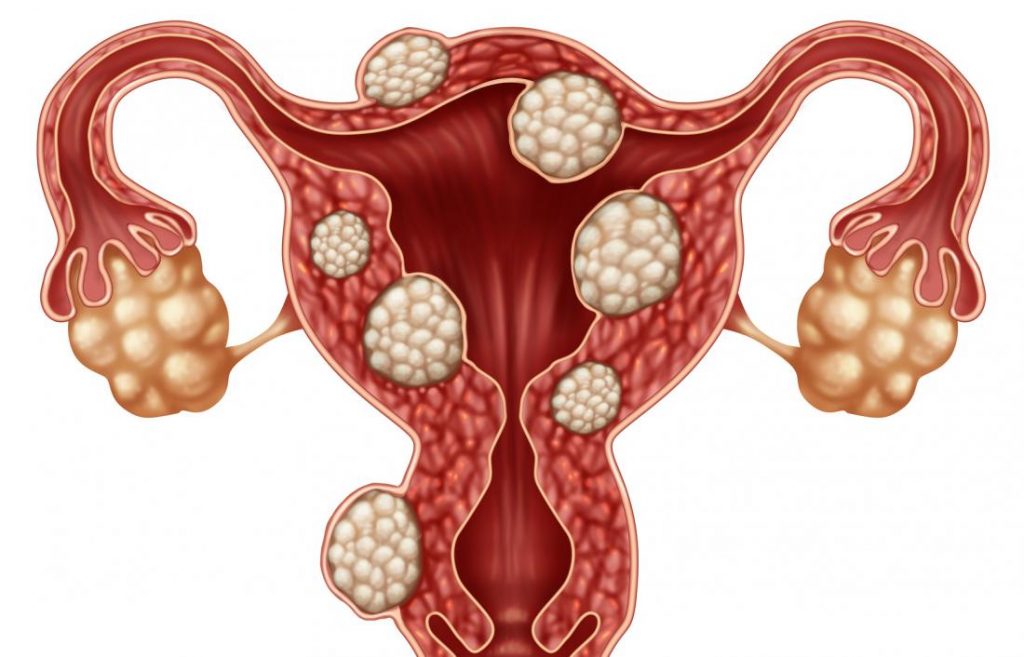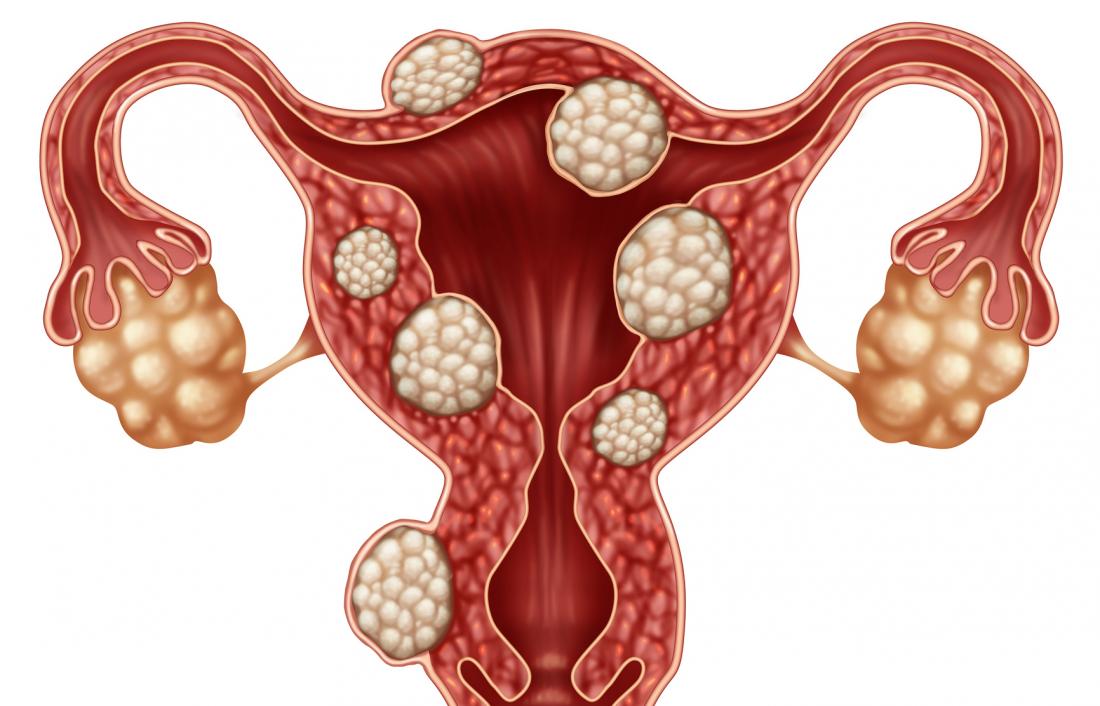A fibroid is myoma of the womb. It is non-malignant growth of smooth muscle tissue enlarging into a mass on the wall of the womb.
Fibroids account for most hysterectomies. Women may have them without knowing and they are more common between the ages of 30 and 40 years.
They depend on oestrogen for their growth. High levels of oestrogen, as found in ‘The Pill’, are believed to increase their size, while low levels cause shrinkage.
Fibroids vary in size, anything from a marble to a turnip or even bigger, usually producing a sense of fullness in the abdomen. After menopause when oestrogen declines, fibroids may shrink and finally disappear. When enlarged, they cause frequent urination and constipation, sometimes resulting in anaemia. They are also a common cause of infertility.
Fibroids symptoms
Many women do not realize they have fibroids until it is discovered as a result of a pelvic examination or prenatal ultrasound. For those who develop large fibroid tumours, signs and symptoms vary depending on location, and may include:
- Heavy menstrual bleeding and prolonged periods and clots
- Anemia (due to heavy bleeding)
- Backache or leg pains
- Constipation
- Infertility and miscarriages
- Pelvic pressure or pain
- Urinary frequency or incontinence
- Excess estrogen (promotes the growth of fibroids)
- Family history (fibroids contain genetic alterations)
- Insulin-like growth factor (may stimulate fibroid growth)
- Race (fibroids are more common among Black women)
- Women with fibroids should not take steroids (they may cause fibroids to grow)
How are fibroids diagnosed?
The first signs of fibroids may be detected during a routine pelvic exam. A number of tests may show more information about fibroids:
- Ultrasonography – uses sound waves to create a picture of the uterus and other pelvic organs.
- Hysterosalpingography – is a special X-ray test. It may detect abnormal changes in the size and shape of the uterus and fallopian tubes.
- Hysteroscopy – uses a slender device (the hysteroscope) to see the inside of the uterus. It is inserted through the vagina and cervix (opening of the uterus). This lets your health care professional see fibroids inside the uterine cavity.
- Laparoscopy – uses a slender device (the laparoscope) to help your health care professional to see the inside of the abdomen. It is inserted through a small cut just below or through the navel. Fibroids on the outside of the uterus can be seen with the laparoscope.
- Sonohysterography – is a test in which fluid is put into the uterus through the cervix. Ultrasonography is then used to show the inside of the uterus. The fluid provides a clear picture of the uterine lining.
- Imaging tests, such as magnetic resonance imaging and computed tomography scans, may be used but are rarely needed. Some of these tests may be used to track the growth of fibroids over time.
There are a number of conventional treatment for fibroids including surgical removal, which is known as myomectomy. There are several herbs and traditional approaches used to alleviate pain and bleeding as well as shrink fibroids, we will explore some of these.
Herbal approach to fibroids
Alternatives: Anti-mitotics – Damiana, Motherwort, Helonias, Life root, Prickly Ash, White Pond Lily, Thuja, Violet leaves (wild), Blue or Black Cohosh.
To arrest bleeding: add Shepherd’s Purse or Beth root.
For pain: Cramp bark.
Tea Formula: Equal parts Corn Silk, Shepherd’s Purse, Violet. 2 teaspoons to each cup of boiling water; infuse for 15 minutes; dose, one cup thrice daily.
Decoction Formula: Equal parts Violet leaves, Clivers, Yellow Dock. 1 teaspoon to each cup of water simmered for 20 minutes. Half-1 cup thrice daily.
Red Clover Formula: For tea and also to make douche.
Castor oil pack: Castor oil packs over the affected area. Three thicknesses of cotton wool or suitable material soaked in Castor oil. Cover with an electric heating pad. Apply 3-4 nights a week for 6 months. The disappearance of fibroid is reported as a result (ARE Journal, Vol 19, May 84, p.127).
Anaemia must be corrected, if present. Nettle tea may be used or other herbal iron formulas.

Fibroids and diet
Foods to avoid
- Meat, dairy, and fish may contain dioxins and other xenoestrogens that can stimulate fibroid growth and worsen symptoms.
- Minimize sugar and caffeine, which can trigger pain and inflammation.
Foods to include:
- Fibre-rich foods such as fruits and vegetables will help extract excessive estrogen stores from the body.
- Cruciferous vegetables such as broccoli, cauliflower, and Brussels sprouts are particularly helpful, as they contain compounds that help the liver detoxify estrogen.
- Choose organic foods whenever possible to reduce ingestion of xenoestrogens from pesticides.
- Foods containing phytoestrogens (plant-based estrogens), such as flaxseed, help balance estrogen levels.
- Artichokes, dandelion greens, and onions contain compounds that support liver function and detoxification of hormones.
- Drink more green tea, as it contains polyphenols that block the negative effects of estrogen and help protect against estrogen-related cancers.
- Those with heavy bleeding may require additional iron to prevent anemia. The best food sources of iron include dark green leafy vegetables, herbs and some dried fruits.
Reference(s)
The American College of Obstetricians and Gynecologists – Frequently Asked Questions FAQ 074 Gynecologic Problems, published Dec. 2018
The Canadian Encyclopedia of Herbal Medicine by Sherry Borkos
Bartram’s Encyclopedia of Natural Medicine by Thomas Bartram
This article is copyrighted by Ital is Vital, 2025. Want to re-post this article? Visit our guidelines.
DISCLAIMER: THIS WEBSITE DOES NOT PROVIDE MEDICAL ADVICE
The information, including but not limited to, text, graphics, images and other material contained on this website are for informational purposes only. The purpose of this website is to promote broad consumer understanding and knowledge of various health topics. It is not intended to be a substitute for professional medical advice, diagnosis or treatment. Always seek the advice of your physician or other qualified health care provider with any questions you may have regarding a medical condition or treatment and before undertaking a new health care regimen, and never disregard professional medical advice or delay in seeking it because of something you have read on this website.
